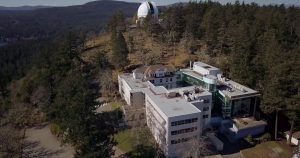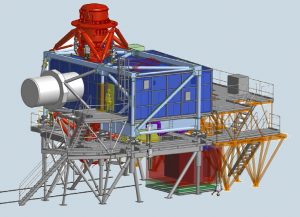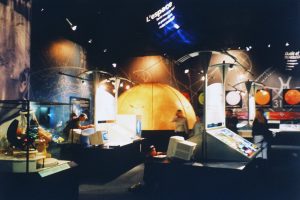Legacy – One Hundred Years Later
One hundred years after it opened, the observatory has become the world-class Herzberg Astronomy and Astrophysics Research Centre (HAA). The 1.8m telescope still operates as a research instrument every clear night. The telescope is now named “The Plaskett Telescope” in honour of John Stanley Plaskett. Advances in technology have made the telescope 10,000 times more sensitive than it first was in 1918. This is mainly because the spectrograph and camera now use electronic cameras rather than photographic plates.
The staff of the observatory has increased greatly over the 100 years since the original office building was constructed. Additions to the building were made in 1953, 1990, and 2000.

A drone photograph of the top of Observatory Hill. The dome of the Plaskett telescope is visible in the background. The building containing offices and laboratories is greatly expanded from the original 1924 building. Joe Carr and National Research Council Canada.
Observatory staff perform astrophysical research and design and build instruments for Canada’s telescopes. This includes telescopes in Hawaii and Chile that Canada partners with. The observatory also operates an elite astronomy data centre. Astronomers can access data from a variety of telescopes including the Hubble and James Webb telescopes.
One of the areas of expertise at the HAA is adaptive optics (AO). This advanced technology corrects for the distortion in stellar images caused by turbulence in the atmosphere. This makes the images of stars and galaxies much sharper and allows astronomers to get better science from the data. Currently, in 2023, the HAA is working on building the AO system for the Thirty Meter Telescope (TMT), one of a new class of extremely large telescopes (ELTs) to be built on Mauna Kea in Hawaii.

A Computer-aided Design model of the adaptive optics system HAA is building for the Thirty Metre Telescope. Once in operation this system will provide images almost 5-times sharper than those from the JWST.
Plaskett invited the public to visit the telescope on the Saturday night following the official opening and the Saturdays after, and this public access to the telescope continues to this day. Each Saturday night during the summer, the Friends of the Dominion Astrophysical Society host a star party. The public can visit the telescope and The Centre of the Universe visitor centre, which was built in 2000.

The interior of the Centre of the Universe (CU) showing some of the exhibits. The CU opened in 2000 and is now operated by the Friends of the DAO. It is open to the public in July and August each year.
The Dominion Astrophysical Observatory had the world’s largest operating telescope in the world when it opened in 1918. This event launched Canada onto the world stage of astronomical discovery. The observatory was part of Victoria’s civic identity and a key aspect of tourism in the 1920s and 1930s.
Today, over 100 years later, the legacy of John Stanley Plaskett’s vision to build the world’s largest telescope lives. Observatory Hill, just north of Victoria, hosts a world-class astronomy research centre. The work done by the motivated people at the centre is helping to maintain Canada as one of the leading countries in astronomical research.

